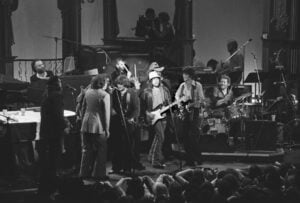The Story Behind ‘Aqualung’ By Jethro Tull
Jethro Tull, formed in 1968, defied typical rock band conventions with their unique lineup, prominently featuring Ian Anderson as founder, lyricist, vocalist, and notably, flutist. Their pivotal album, Aqualung, released in April 1971, showed Anderson’s multifaceted talents and the band’s innovative approach to the rock music scene.
The album opens dramatically with the title track, “Aqualung,” showcasing Anderson’s distinctive vocal delivery and the flute’s unconventional role in the rock genre. The music seamlessly transitions between fast-paced and slower moments, maintaining its rhythmic intensity and dynamics throughout.
Aqualung didn’t just serve as the album’s title but also became a rock anthem of the 1970s, etching itself into the annals of popular music history. The album cover, featuring a striking image captured by Anderson’s first wife, Jennie Franks, further adds depth to its narrative. The photo was taken during Jennie’s art school project at Victoria’s Salvation Army. It vividly portrays a homeless man known as Aqualung, embodying the stark realities of urban life and human struggles.
Ian Anderson’s evocative storytelling, complemented by the flute’s playful yet haunting melodies, brings Aqualung’s character to life in this song. The album deeply focuses on themes of societal neglect, capturing Aqualung’s observations of life from the fringes, where he watches passersby with a mix of curiosity and cynicism.
With its mesmerizing flute riffs and Anderson’s poignant vocals, this track solidified Jethro Tull’s reputation as a trailblazer in progressive rock. Beyond its title track, the album features intricate compositions and frenzied solos that set new standards in musical complexity and thematic depth.
While Jethro Tull would later explore other ambitious projects like “Thick as a Brick,” known for its sprawling conceptual narrative, “Aqualung” remains a strong mark of their discography— it’s a masterpiece that continues to be hailed for its innovation and enduring influence in rock music history.













